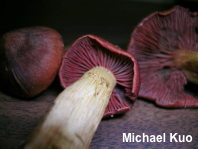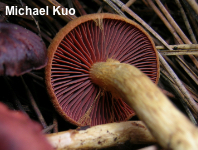| Major Groups > Gilled Mushrooms > Dark-Spored > Cortinarius > Cortinarius smithii |

|
Cortinarius smithii [Basidiomycota > Agaricales > Cortinariaceae > Cortinarius ... ] by Michael Kuo Among the species of Cortinarius with deep red gills and finely silky, dry cap surfaces, the Pacific Northwest's Cortinarius smithii is easily separated on the basis of its red cap and its contrasting yellowish stem. Look for this gorgeous species under conifers in fall and winter. Similar species within the range of Cortinarius smithii include two species with red, rather than yellow, stems: the Sierra Nevada's Cortinarius sierraensis has orangish red colors, while the Pacific Coast's Cortinarius neosanguineus is red to purplish red. Cortinarius phoeniceus occidentalis is a synonym. Description: Ecology: Mycorrhizal with conifers; growing scattered or gregariously; fall and winter (at higher elevations it is sometimes found in late summer); originally described from Oregon; distributed from northern California to Alaska. The illustrated and described collections are from California. Cap: 3–8 cm; broadly convex, becoming broadly bell-shaped or nearly flat; dry; silky; deep red to maroon; the margin usually somewhat inrolled. Gills: Attached to the stem; distant or nearly so; dark red to purplish red, becoming rusty red; short-gills frequent; when young covered by a yellowish cortina that quickly disappears. Stem: 4–7 cm long; 5–10 cm thick; more or less equal; dry; silky with yellowish or reddish fibers; yellowish, or discoloring reddish with age; sometimes with a rusty ring zone. Flesh: Yellowish; unchanging when sliced. Odor: Not distinctive. Spore Print: Rusty brown. Microscopic Features: Spores 6–8 x 4–4.5 µm; ellipsoid; moderately verrucose; brown in KOH. Hymenial cystidia not found. Pileipellis a cutis; elements 5–18 µm wide, smooth, reddish to purplish red in KOH, clamped at septa. REFERENCES: J. F. Ammirati, T. Niskanen & K. Liimatainen, 2013. (Smith, 1939; Smith, Smith & Weber, 1979; Ammirati & Smith, 1984; Arora, 1986; Ammirati, 1989; Miller & Miller, 2006; Trudell & Ammirati, 2009; Niskanen et al., 2013; Desjardin, Wood & Stevens, 2015; Siegel & Schwarz, 2016.) This site contains no information about the edibility or toxicity of mushrooms. |
© MushroomExpert.Com |
|
Cite this page as: Kuo, M. (2022, January). Cortinarius smithii. Retrieved from the MushroomExpert.Com Web site: http://www.mushroomexpert.com/cortinarius_smithii.html |

